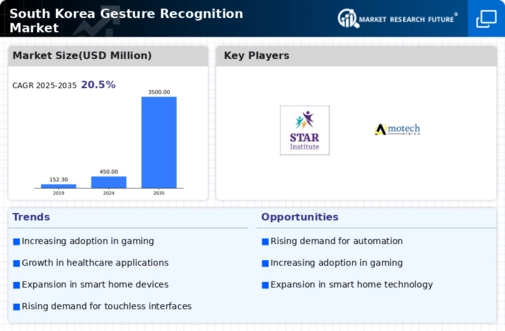Technological Advancements in AI
The gesture recognition market in South Korea is experiencing a surge due to rapid advancements in artificial intelligence (AI) technologies. These innovations enhance the accuracy and efficiency of gesture recognition systems, making them more appealing for various applications. For instance, the integration of machine learning algorithms allows for improved pattern recognition, which is crucial for applications in gaming and virtual reality. The market is projected to grow at a CAGR of approximately 25% over the next five years, driven by these technological improvements. As AI continues to evolve, the gesture recognition market is likely to see increased investment and development, further solidifying its position in the tech landscape.
Increased Investment in Smart Cities
The South Korean government's commitment to developing smart cities is a key driver for the gesture recognition market. As urban areas become more technologically advanced, the need for intuitive and efficient human-computer interaction systems grows. Gesture recognition technology is being integrated into various smart city applications, including traffic management and public safety systems. The gesture recognition market is likely to benefit from this trend, with investments in smart city projects expected to exceed $10 billion by 2027. This influx of funding will facilitate the development of innovative solutions that leverage gesture recognition to improve urban living.
Rising Demand for Touchless Interfaces
In South Korea, the growing demand for touchless interfaces is significantly influencing the gesture recognition market. This trend is largely driven by consumer preferences for hygiene and convenience, particularly in public spaces and smart devices. The gesture recognition market is adapting to this shift by developing systems that allow users to interact with devices without physical contact. This is particularly relevant in sectors such as retail and hospitality, where touchless technology can enhance customer experiences. Market analysts estimate that the touchless interface segment could account for over 30% of the overall gesture recognition market by 2026, indicating a robust growth trajectory.
Growing Adoption in Education Technology
The gesture recognition market is also witnessing growth due to its increasing adoption in education technology within South Korea. Educational institutions are exploring innovative ways to enhance learning experiences, and gesture recognition technology offers interactive and engaging methods for students. This trend is particularly evident in STEM education, where gesture-based learning tools can facilitate hands-on experiences. The gesture recognition market is likely to see a rise in demand for educational applications, with projections indicating a potential market size of $500 million by 2026. This growth reflects a broader trend towards integrating technology in education, aiming to improve student engagement and learning outcomes.
Expansion of Gaming and Entertainment Sectors
The gaming and entertainment sectors in South Korea are rapidly expanding, creating a fertile ground for the gesture recognition market. As consumers increasingly seek immersive experiences, gesture recognition technology is becoming a vital component in gaming consoles and virtual reality platforms. The gesture recognition market is projected to capture a significant share of this growth, with revenues from gaming applications expected to reach $1.5 billion by 2025. This expansion is driven by the demand for more interactive and engaging gameplay, which gesture recognition can uniquely provide, thereby enhancing user satisfaction and engagement.













Leave a Comment